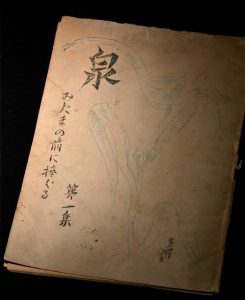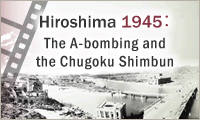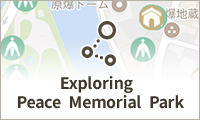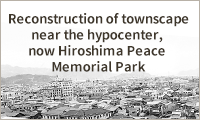Documenting Hiroshima of 1946: August 1, first collection of Hiroshima A-bomb survivors’ personal accounts
Aug. 1, 2025
by Minami Yamashita, Staff Writer
On August 1, 1946, the first collection of Hiroshima A-bomb survivors’ personal accounts, titled Izumi: Mitama no Mae ni Sasaguru (in English, ‘Springs: Offering before departed souls’), was published. Surviving classmates wrote and contributed most of the personal accounts of the A-bombing experiences that appear in the collection to express their condolences to the students of class 3-5 (third year, fifth class) at Hiroshima First Middle School (present-day Kokutaiji High School, located in Hiroshima City’s Naka Ward) who had died in the atomic bombing.
The B5-size, 63-page book was adorned with a spiderwort flower printed on the cover, inspired by the purple of the school’s flag. Personal accounts of 39 survivors are contained in the book, which was printed on coarse paper using a mimeograph.
The book included such descriptions as, “Believing you surely survived, I prayed that you would be well,” and “I cannot forget your strong body, your smile, and your voice, which are still fixed in my mind.” In addition to the memories of “our departed friends,” the students also wrote about what happened at the time of the atomic bombing. The title of the collection was adopted from one of the sentences contained within, which read, “Nostalgic memories from the past bubbled up like water from a spring.”
Students in class 3-5 had been mobilized to engage in building-demolition work in the area of Koami-cho (in Hiroshima’s present-day Naka Ward), located around 800 meters from the hypocenter. In a survey conducted by the classmates after the bombing, 42 students were found to have died at that time.
Katsumi Nakamoto, a member of class 3-5 who had survived the bombing and died in 2002, was the one who had proposed putting together a memorial collection of writings. Mr. Nakamoto was quoted as saying in an article carried in the Chugoku Shimbun on July 21, 1986, “Students at First Middle School were skilled at making aircraft parts. However, we were ordered to set aside the aircraft-production work and help in the demolition of buildings as mobilized students. I was upset about the order and took the day off from the work, claiming I had a cold, which was the reason I survived. My sense of guilt might have led me to make the proposal.”
To publish the book in time for the commemoration of the first-year anniversary of the deaths in the atomic bombing, those classmates as well as students from Hiroshima Prefectural First Girls’ High School (present-day Minami High School), who had been mobilized to work at the same factory, submitted their personal accounts. The collected personal accounts had been written on a variety of different types of paper such as manuscript sheets and paper and stationary. In the editor’s note in the book, Mr. Nakamoto wrote, “While reading, I felt my heart gradually soften. That feeling went beyond whether the writing was good or bad.” Around 100 copies were printed and distributed to the contributing writers.
Masaru Nanko, 94, a resident of the town of Fuchu-cho in Hiroshima Prefecture who was a student in the same school year as class 3-5 but in a different class, said, “I remember them when I see their names. Those personal accounts were written precisely because the surviving students were thinking about their friends at school.” At the time of the atomic bombing, Mr. Nanko had been mobilized to work at Toyo Kogyo (present-day Mazda Motor Corporation) in Fuchu-cho, Hiroshima Prefecture. His younger brother Osamu, 12 at the time and a first-year student at Hiroshima First Middle School, died in the atomic bombing while mobilized to work near the school building in the area of Zakoba-cho (in Hiroshima’s present-day Naka Ward).
In 2008, the “Springs” collection was donated by Shiro Nakayama, a writer and one of the contributors to the collection who died in 2022, to the Hiroshima Peace Memorial Museum. It is said to be the only copy of the collection archived at the museum.
(Originally published on August 1, 2025)
On August 1, 1946, the first collection of Hiroshima A-bomb survivors’ personal accounts, titled Izumi: Mitama no Mae ni Sasaguru (in English, ‘Springs: Offering before departed souls’), was published. Surviving classmates wrote and contributed most of the personal accounts of the A-bombing experiences that appear in the collection to express their condolences to the students of class 3-5 (third year, fifth class) at Hiroshima First Middle School (present-day Kokutaiji High School, located in Hiroshima City’s Naka Ward) who had died in the atomic bombing.
The B5-size, 63-page book was adorned with a spiderwort flower printed on the cover, inspired by the purple of the school’s flag. Personal accounts of 39 survivors are contained in the book, which was printed on coarse paper using a mimeograph.
The book included such descriptions as, “Believing you surely survived, I prayed that you would be well,” and “I cannot forget your strong body, your smile, and your voice, which are still fixed in my mind.” In addition to the memories of “our departed friends,” the students also wrote about what happened at the time of the atomic bombing. The title of the collection was adopted from one of the sentences contained within, which read, “Nostalgic memories from the past bubbled up like water from a spring.”
Students in class 3-5 had been mobilized to engage in building-demolition work in the area of Koami-cho (in Hiroshima’s present-day Naka Ward), located around 800 meters from the hypocenter. In a survey conducted by the classmates after the bombing, 42 students were found to have died at that time.
Katsumi Nakamoto, a member of class 3-5 who had survived the bombing and died in 2002, was the one who had proposed putting together a memorial collection of writings. Mr. Nakamoto was quoted as saying in an article carried in the Chugoku Shimbun on July 21, 1986, “Students at First Middle School were skilled at making aircraft parts. However, we were ordered to set aside the aircraft-production work and help in the demolition of buildings as mobilized students. I was upset about the order and took the day off from the work, claiming I had a cold, which was the reason I survived. My sense of guilt might have led me to make the proposal.”
To publish the book in time for the commemoration of the first-year anniversary of the deaths in the atomic bombing, those classmates as well as students from Hiroshima Prefectural First Girls’ High School (present-day Minami High School), who had been mobilized to work at the same factory, submitted their personal accounts. The collected personal accounts had been written on a variety of different types of paper such as manuscript sheets and paper and stationary. In the editor’s note in the book, Mr. Nakamoto wrote, “While reading, I felt my heart gradually soften. That feeling went beyond whether the writing was good or bad.” Around 100 copies were printed and distributed to the contributing writers.
Masaru Nanko, 94, a resident of the town of Fuchu-cho in Hiroshima Prefecture who was a student in the same school year as class 3-5 but in a different class, said, “I remember them when I see their names. Those personal accounts were written precisely because the surviving students were thinking about their friends at school.” At the time of the atomic bombing, Mr. Nanko had been mobilized to work at Toyo Kogyo (present-day Mazda Motor Corporation) in Fuchu-cho, Hiroshima Prefecture. His younger brother Osamu, 12 at the time and a first-year student at Hiroshima First Middle School, died in the atomic bombing while mobilized to work near the school building in the area of Zakoba-cho (in Hiroshima’s present-day Naka Ward).
In 2008, the “Springs” collection was donated by Shiro Nakayama, a writer and one of the contributors to the collection who died in 2022, to the Hiroshima Peace Memorial Museum. It is said to be the only copy of the collection archived at the museum.
(Originally published on August 1, 2025)








